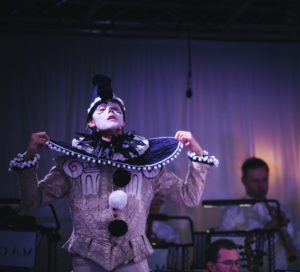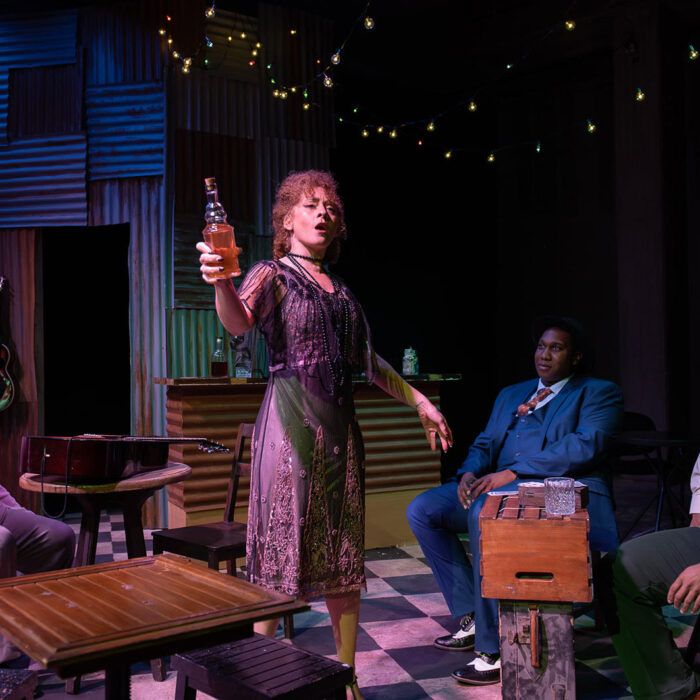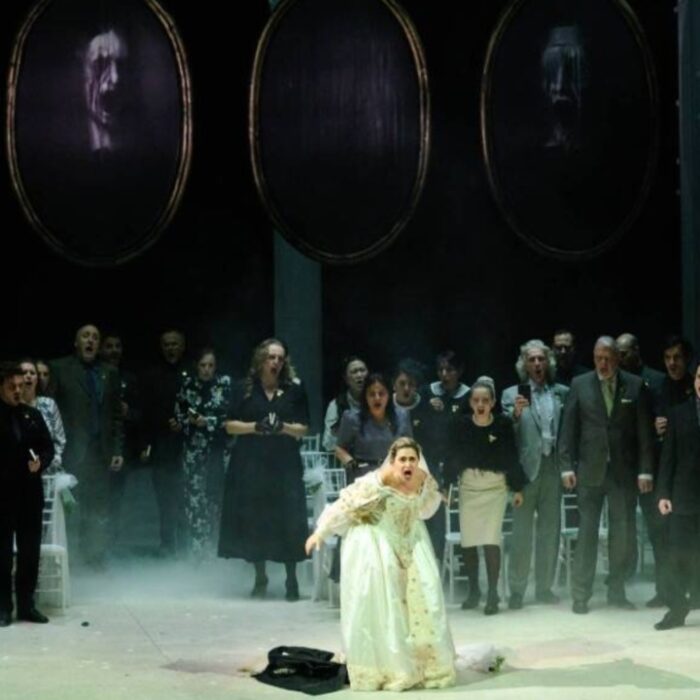
Vache Baroque Festival 2022 Review: La Descente d’Orphée Aux Enfers
Pansard-Besson’s Strong Presentation Highlights The Contrasts Within The Work
By Alan Neilson(Photo: The Photography Shed)
Situated in the shade of the Chiltern Hills on the outskirts of London lies The Vache, a country house dating from the 16th century, with extensive grounds covering 86 acres. In 2020, it became the venue for Vache Baroque, a late summer festival dedicated to the performance of baroque music, under the stewardship of Betty Makharinsky and Jonathan Darbourne.
This year’s festival, which ran from September 1st to 4th, presented two vocal works, Marc-Antoine Charpentier’s “La Descente d’Orphée aux Enfers” and Giacomo Carissimi’s short oratorio “Jephte,” as well as a recital from the Vache Baroque Band.
The atmosphere was welcoming and relaxed, with visitors encouraged to explore the grounds and picnic on its lawns. For the payment of a coin, it was even possible to cross the River Styx and enter the island of Hades. There were two performance areas: the Main Stage, situated next to the house, offering comfortable seating with excellent sight lines, on which “La Descente d’Orphée aux Enfers” was performed; and the Woodland Stage, on which the other events took place, which is set among the trees close to the lake, with scattered bales of straw used for seating.
The Woodland Stage
Carissimi’s oratorio, written in the mid-17th century, kicked off proceedings. The setting among the trees, on what was a warm sunny day, with a few threatening grey clouds in the distance still some way off, proved an ideal location. Even the straw bail seats were very comfortable and added to the relaxed, informal atmosphere. Although a minimalist production consisting of only seven singers and three musicians, it proved to be an interesting presentation in which the two principals, tenor Lars Fischer and soprano Lauren Lodge-Campbell, brought depth to their characters with their intelligently crafted phrasing. The intimate outdoor location meant that the qualities of all the voices were clearly audible, which not only highlighted the singers’ individual qualities but allowed for the textural beauty of their combined singing to be fully appreciated.
The performance was followed by an instrumental recital by members of the Vache Baroque Band.
Written in 1686 to a libretto by an unknown author, “La Descente d’Orphée aux Enfers” relates the well-known tale of Orphée’s descent into Hades to recover his bride Euridice. However, either because of a decision on the part of Charpentier to deliberately terminate the opera at the end of Act two, or because Act three has been lost, there is no conclusion. Does Orphée look back and lose Euridice forever? We do not know. And what happens to him when he returns from the Underworld? Again Charpentier remains silent.
Either fortuitously or with an eye on the time of the sunset, it so happened that Act one, located in the realm of the living, took place under the early evening sunlight, whilst Act two, located in the Underworld, was played out against the enveloping darkness caused by the setting sun, which gave the two acts distinctly different flavors, fully consistent with their different settings. It also enhanced the staging devised by the director, Jeanne Pansard-Besson, set and costume designer Laura Jane Stanfield, and lighting designer Andrew Ellis, who used the contrasting colors of light and dark to define the acts: soft pastel shades for the realm of the living, and black and darker colors for the Underworld.
The stage was neatly designed, so that the orchestra was situated on a raised platform in the rear, whilst the front was used for the soloists, dancers and a few simple props. Steps led down from the front of the stage, which enabled the singers occasionally to spill out onto the grass.
The heart of the presentation relied on strong contrasts, not just in their coloring, but also in the costuming and movement of the singers, and the dancing of the BirdGang Ltd Dancers, choreographed by Simeon Qsyea. Act one, at least up to the point of Euridice’s death was characterized by elegance and joy, with the cast dressed for the wedding. Flowers adorned the stage and the dancing was calm and graceful. Even the orchestra was dressed for the occasion, and joined in the fun by appearing as a dance band.
On the other hand, Act two was dark, very dark! The souls of the damned were dressed in expertly designed black and white clown costumes which reflected their specific torments, with their misery and suffering etched on their faces. The movements of the Furies and the Guilty Souls were angular and disjointed, their dancing sharp and disturbing. Even the orchestra, now costumed in a ghostly shade of white, had lost its color.
Visually and dramatically, it was an aesthetically pleasing, imaginative and well-crafted staging. The only negative criticism being that there was a tendency to overpopulate the stage so that, at times, it appeared crowded and cluttered, with too much movement.
The musical side of the production was under the direction of the company’s artistic director, Jonathan Darbourne, who elicited an elegant, graceful performance from the Vache Baroque Band. He provided nicely wrought rhythmic and dynamic contrasts to support the dramatic needs of the work and ensured that the dances had plenty of vitality, yet nothing was ever overstated; the overriding aesthetic was always one of balance and charm.
Boden Leads The Way
The cast was comprised of mainly young singers with varying degrees of experience, and two well-established figures in the form of haute-contre Samuel Boden, and bass-baritone Henry Waddington.
Boden was parted as Orphée, who acted out the role in an idealized manner, without the need for any physical histrionics; everything was understated but clearly conveyed. His singing, however, brought the full force of his emotions to the fore, as he spun out delicate, detailed, clearly articulated lines, inflected with subtle coloring and coated with emotion. His reaction to Euridice’s death was captured wonderfully in the air “Ah! Bergers, c’en est fait,” in which he lays bare Orphée’s pain, while the air “ Souviens toi du larcin,” in which he appeals to Pluton to allow Euridice to return, showed off the excellent quality of his delicate phrasing and vocal versatility as he pleads his case. Moreover, his singing exhibited precision and a confidence that could not fail to impress.
Waddington, dressed in a flamboyant black suit, made for an authoritative god of the Underworld. He strolled around the stage in a controlled, calm manner, which brilliantly highlighted his total disinterest in the suffering of the tormented souls around him. He established excellent working relationships with both Boden and Chrisp, which produced a lively dynamic, with their sung interactions producing the most satisfying exchanges of the evening.
The younger singers, who had all performed in “Jephte” earlier in the day, engaged enthusiastically with their roles and without exception, sang well and showed real quality in acting out their parts.
Soprano Lauren Lodge-Campbell, who was parted as Filia in “Jepthe,” made a strong impression with her Act one portrait of Euridice, whom she depicted as a deeply in-love, carefree, happy soul. She possesses an attractive, clear and clean-sounding singing voice with a light vibrato, which she used intelligently to craft delicately woven phrases, tailored to express her feelings of joy.
Mezzo-soprano Lila Chrisp also made an excellent impression with her performance as Proserpine, Plutone’s queen. She produced a confident performance in which her richly textured voice with its dark hues contrasted beautifully with its brighter colors, and successfully displayed her vocal versatility with pleasingly delivered passages of coloratura. She was also parted in the smaller role of the nymph Arethuze.
Having earlier in the day successfully appeared in the title role of Jepthe, tenor Lars Fischer put in another strong performance in the role of Tantale, which again allowed him to show off his ability to characterize his role through his voice.
Soprano Naho Koizumi has a strong, attractive voice, which she used skillfully to characterize her role as the naiad Daphné.
Likewise, soprano Katie-Louise Dobson displayed skill with her portrayal of the nymph Enone, in which the sense of freedom she brought to her singing was particularly pleasing.
Countertenor Alexander Chance has a strong stage presence, which he used well to draw attention to his long-suffering character, Ixion. He has a voice that is easy on the ear, which he moulded appropriately to bring out his character’s pain and then his subsequent relief when he experienced Orphée’s singing.
Jamie Woollard was double-parted as Apollon and Tityé. He possesses an attractive bass with a strong resonance, which he employed intelligently in crafting his lines, which possessed both emotional depth and beauty.
Although it is still only in its third year, Vache Baroque is proving itself to be a worthwhile addition to the English summer music festival calendar, and with baroque opera’s popularity still on the rise, there is no reason why it cannot continue well into the future. Certainly, based on the offerings at this year’s festival, Mahkarinsky and Darbourne have what it takes to achieve success; they have the vision and the skills, admirably displayed by this year’s performance of Charpentier’s “La Descente d’Orphée aux Enfers.”



